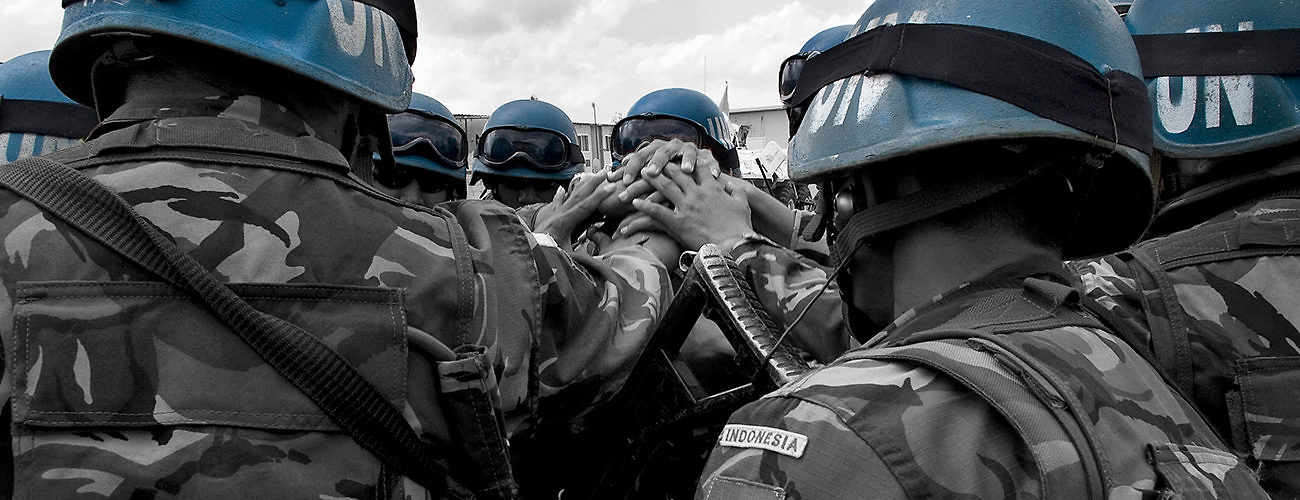UNIFIL soldiers getting ready to leave base join hands before departing on for a patrol in south Lebanon on August 28, 2009. (UN Photo/Pasqual Gorriz)
Improving the Security of United Nations Peacekeepers (now universally known as the Cruz Report after its lead author) has one feature that distinguishes it from other United Nations documents. It is readable.
The prose is workmanlike but effective. Lieutenant General Carlos Alberto dos Santos Cruz and his co-authors make pithy and provocative points such as “hostile forces do not understand a language other than force.” This is a stark contrast to most UN reports, which typically consist of one overlong paragraph stacked on top of another. All UN officials should read the Cruz report to remind themselves how to write.
The style of the report matters because, as other contributors to this series have noted, the substance is not actually that radical. Peacekeepers should be better equipped. The UN needs stronger command and control arrangements. The organization needs improved hospitals. This is all important, but standard fare.
But the report’s language is different than normal, and the difference matters. In recent years, policy debates about peacekeeping have largely been framed in the language of mediators and development experts. The 2015 High-Level Independent Panel on Peace Operations (HIPPO) set the standard, emphasizing the “primacy of politics” in peacemaking and nodding to the Sustainable Development Goals by calling for “sustainable peace.” Secretary-General Antonio Guterres has taken his rhetorical cues from the HIPPO, talking about the importance of sustainable peace, prevention and a “surge of diplomacy.”
Language, as French philosophers like to point out, is power. The current phraseology of peace operation indicates that, at least within the UN bubble, civilian officials dominate strategic discussion. The HIPPO team included seventeen senior UN figures (with, as they liked to point out, about half a millennium of operational experience between them) but only two of them were soldiers. These military men, General Floriano Peixoto Vieira Neto of Brazil and Lieutenant General Abhijit Guha of India, were thoughtful and loyal members of the group. But they were also quite cautious, not only in their views on the military dimensions of peace operations but also in how they engaged in debate with their fellow civilian panelists.
The net result was, as Louise Riis Andersen notes in an excellent new article on the HIPPO, a report that did not focus on military priorities but “produced a narrative that emphasized the limits of UN peacekeeping” and deliberately pushed back against the potential “militarization” of UN peacemaking.
Military issues have, of course, not been utterly forgotten at the UN. Organizations including the International Peace Institute have done excellent work profiling troop contributors and digging into the finer points of logistics and military aviation. At a higher level, and in parallel with the HIPPO process, the Obama administration launched a successful process to persuade more countries to provide blue helmets.
But while the Obama initiative helped boost the UN’s military capacities, both the US and its partners have tended to frame their force generation efforts in terms similar to those of the HIPPO. President Obama warned other leaders that, even if they strengthened UN forces, “we cannot expect peacekeeping operations to succeed unless the parties involved are willing and committed to making peace.”
Overall, both the HIPPO report and ensuing debates at the UN have thus implicitly marginalized military perspectives on peace operations. The Cruz report arguably rebalances the terms of debate a little by bringing a clear military voice—favoring un-HIPPO-ish terms like “overwhelming force”—back to the table.
You don’t have to buy into the report’s bellicose stylings to think this is a good thing. Like it or not, the UN has 100,000 uniformed peacekeepers worldwide. The idea that they have little to contribute to debates about future operations, and are instead a colorful backdrop to the decisive work of mediators and aid experts, is patronizing. The UN policy community needs to listen to military voices more closely.
If we did, we would certainly find that far from all these voices echo the Cruz report faithfully or at all. Having directed kinetic operations in Haiti and the Democratic Republic of Congo, General Santos Cruz represents an unusually hawkish variety of UN general. His unforgiving views on when and how to use force are closer to that of a NATO officer than those of more mainstream non-Western peacekeepers.
Those looking for an alternative military perspective could turn to a recent essay by Major General A.K. Bardali, an Indian officer and former Deputy Force Commander of the UN Interim Force in Lebanon, who argues that those who “look at every incident in the mission through a military prism and try to separate the black from the white” miss that in peacekeeping “there are more greys than combined blacks and whites.”
General Santos Cruz would presumably dismiss this as evidence of the “Chapter VI syndrome” he believes permeates UN units. There is a spectrum of military views on peace operations, and the Cruz report is only a compellingly bluff articulation of one point of view. Agree or disagree with it, civilian UN officials and analysts should take it as a prompt to treat their uniformed counterparts with a little more respect.
Richard Gowan is a Senior Fellow at the European Council on Foreign Relations, Adjunct Professor at Columbia University, and Non-Resident Fellow at the NYU Center on International Cooperation.
This article is part of a series being published in February by the Global Observatory on the report of Lieutenant General Carlos Alberto dos Santos Cruz on peacekeeping fatalities and injuries. The Cruz report comes amid a broader strategic review of peacekeeping missions, focused on how the UN can adapt to the changing nature of conflict.





